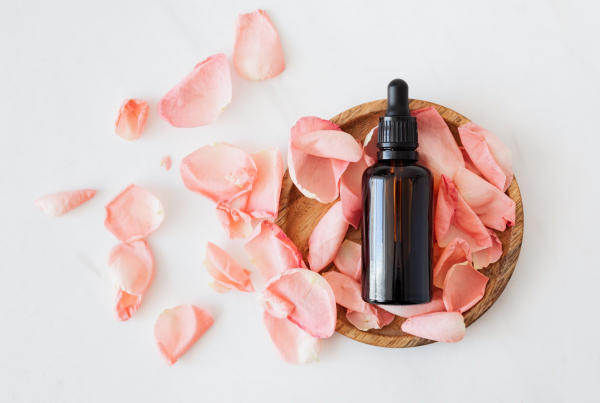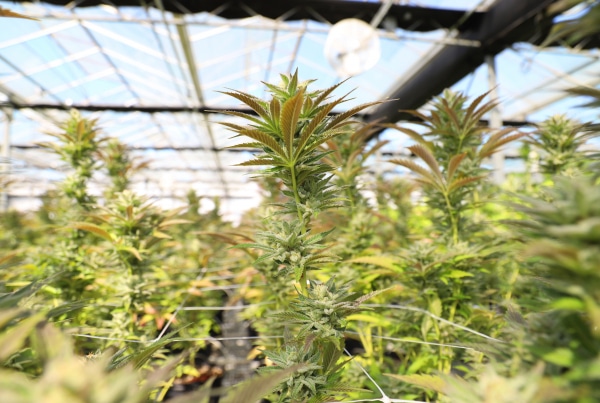
Disclaimer: This content is not intended to be a substitute for professional medical advice, diagnosis, or treatment. Always seek the advice of your physician or other qualified health provider with any questions you may have regarding a medical condition.
Inflammation is one of the immune system’s “first responders,” so there’s no surprise that it’s involved with nearly every chronic condition, injury, or other ailment that incites an immune response. In fact, inflammation is often one of the top symptomatic concerns for people with arthritis, cardiovascular disease, allergies, diabetes, chronic obstructive pulmonary disease (COPD), and more.
Inflammation is also a primary concern on the other end of the wellness spectrum, by those who regularly hit the gym and put their muscles to the stress test. Muscles swell after they are stressed, and excess inflammation can even slow recovery time and decrease gains.
How Does CBD Help With Inflammation And Muscle Soreness?
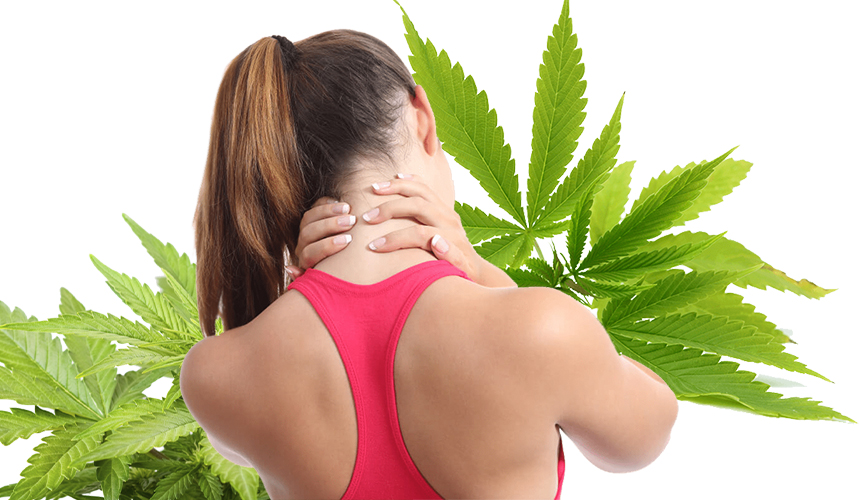
It’s really no surprise that so many people are paying close mind to inflammatory symptoms. Inflammation is, in fact, usually the main cause of discomfort related to these conditions, is a precursor to pain, and can cause lasting or permanent damage to muscle and nerve tissue.
Generally, over-the-counter or prescription strength nonsteroidal anti-inflammatory drugs (NSAIDs) are used to combat inflammation, but these medications also host a slew of potential side effects, like stomach pain or ulcers, headaches, liver damage, high blood pressure, and more. What’s more is they are often taken in high doses on a regular basis—a sure way to significantly increase the risk of heart attack, stroke, stomach bleeding, and permanent damage to the kidney and liver.
Luckily, there’s another option that’s quickly emerging in the wellness industry as a substitute for many of these harmful medications. Cannabidiol (CBD), naturally derived from cannabis, has shown promising anti-inflammatory effects that may make it useful for most people, like those dealing with inflammatory conditions or injuries.
CBD is also gaining popularity among athletes as a post-workout anti-inflammatory remedy. According to the strong supporting evidence we have, it really could be useful to anyone who wants to keep a powerful anti-inflammatory on hand—just in case!
What Is The Correct CBD Dosage To Help Treat Inflammation And Muscle Soreness?
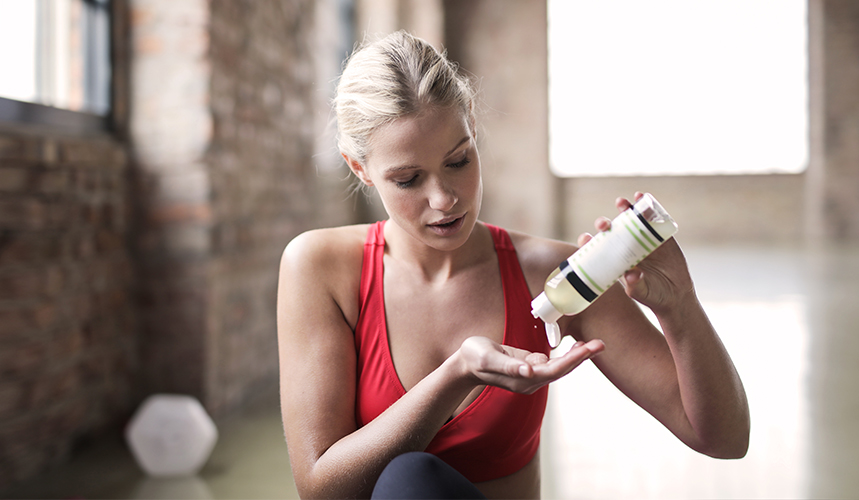
Dosing is a personal experience for every CBD user, and the amount of CBD needed to manage your symptoms depends on a number of factors, like your weight, tolerance to cannabinoids, condition, and the severity of your symptoms. We often recommend a “start low and go slow” technique for finding your best dosage.
We suggest those suffering from any kind of inflammation start with 15mg per day of CBD. If this dosage doesn’t fully relieve symptoms, we suggest increasing by 5-10mg until you experience relief. A CBD tincture can help with this dosing approach since you can easily measure out each dose in small increments.
Gel capsules provide a different experience. They offer pre-measured doses that are convenient for those who often dose on-the-go or those who need larger doses of CBD. You can start with whatever dose the brand you choose offers, and there’s no harm in starting higher than 15mg since you can’t overdose on CBD and there are no significant side effects.
From there, slowly increase your dose as needed, but be sure to allow plenty of time to monitor effects. Remember that ingestibles like capsules and tinctures can take a while to kick in— up to 90 minutes to feel the full effects.
Dosing for CBD topicals is a bit different, and you need to use an adequate amount for the affected area. Topical products typically work quickly, providing relief in less than 20 minutes. Apply CBD topicals as needed throughout the day to manage inflammation.
Vaping is much different because it can be difficult to monitor the amount of CBD you’re consuming with each puff. It’s even easier to apply the low and slow approach here, because the effects of vaporized CBD are usually in full swing after only 10 minutes. When vaping, start with one or two small puffs, wait ten minutes to monitor the effects, and then repeat the process until you experience complete relief.
Topical CBD For Muscle Pain: Alleviating Pain & Spasms With CBD
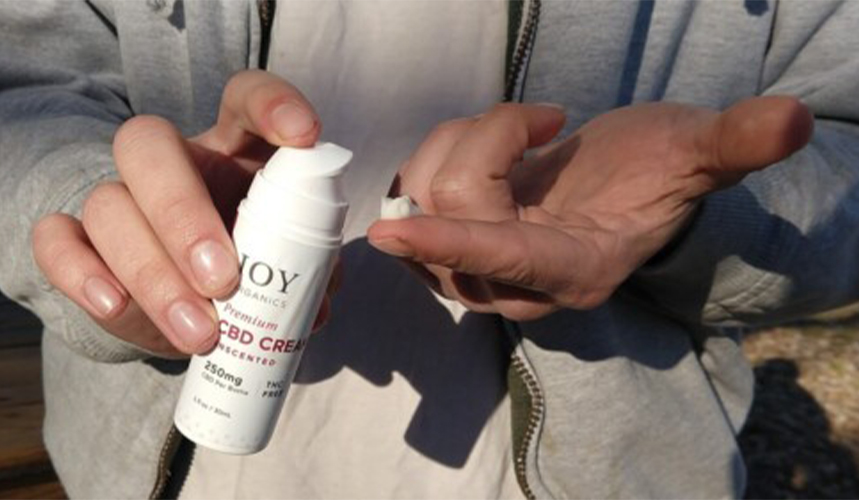
Muscle pain and discomfort is a fact of life for everyone at some point, and topical products are often a first line of defense against it. Whether it’s caused by tension, injury, an especially intense workout, or chronic illness, many people find relief from muscle pain by using topical pain reliefproducts. When occasional pain becomes chronic, however, it often becomes more difficult to treat. Topical CBD can help to treat chronic pain even more effectively than opioids in some patients.
Chronic muscle pain (and honestly, chronic pain in general) is especially difficult to address effectively, and many people feel forced to turn to opioid painkillers (transdermal and otherwise) and other pharmaceutical products for relief. Not only are these interventions often ineffective at curbing chronic pain, they also carry a high risk of addiction and a number of unpleasant side effects.
A growing number of chronic pain sufferers are looking to manage their symptoms without resorting to opioids, turning instead to CBD. CBD, the common name for the molecule cannabidiol, has been shown to be an effective remedy for chronic pain — more effective than opioid pain relievers.
Derived from hemp (a close cousin of cannabis), CBD has anti-inflammatory, analgesic, anxiolytic, antispasmodic, hypnotic, and antiemetic properties, among many others, and may be applicable to therapies for a diverse array of conditions and symptoms.
While CBD is often taken orally in the form of tinctures or softgels, its medicinal properties extend to topical application as well. This allows CBD to be used to treat pain more directly, at the site of soreness or tension, alleviating symptoms more quickly than oral delivery systems. It may also help to soothe muscle spasms and cramping when used topically.
Topical CBD products offer many different opportunities for people to manage (and even eliminate) chronic muscle pain, tension, and spasms safely and effectively, especially in combination with a systemic dose of CBD. However, topical products often contain many more supporting ingredients than oral formulas. This makes them more likely to be made with potentially inflammatory or allergenic ingredients that can reduce the effectiveness of the CBD they contain — not to mention wreak havoc on your skin.
Here, we’ll cover everything you need to know about the most effective supporting ingredients for topical CBD pain relief. We’ll discuss the science of CBD topicals and their role in pain management before explaining how to use temperature therapies to manipulate pain perception.
Then we’ll move on to discussing topical CBD supporting ingredients in detail, from carrier oils to botanicals to additives. We’ll examine the benefits different ingredients offer, along with any risks associated with their use. Finally, we’ll close with a note about sustainable ingredients and the environmental impact of CBD topicals.
The Science of Topical CBD & Pain Management
While more research is needed, CBD is demonstrated to possess potent anti-inflammatory, analgesic, and antispasmodic effects in humans. These benefits aren’t limited to oral consumption or inhalation, either — CBD acts on many of the same pathways in the skin when applied topically. This can help to alleviate pain, reduce cramps and spasms, and release tension from sore or overworked muscles.
Existing research shows CBD to be a promising ingredient in topical pain relief products, and while many of the exact mechanisms are still unclear, the results are pretty compelling. What we know so far suggests that CBD engages with endocannabinoid receptors in the skin, helping to promote circulation, relieve inflammation, reduce spasms, and alleviate pain in muscles.
Because they are applied at the site of pain, CBD topicals are quicker to provide relief than an oral dose of CBD. For this reason, it may be especially beneficial for people looking to manage symptoms that come on suddenly or rapidly spike in severity, such as cramping or muscle spasms. Topical CBD can also aid muscle relaxation and soothe tension, making it a good addition to massage oils and salt soaks as well.
Because of the wide variety of product types that can incorporate the benefits of CBD into their formulas, there are many ways to customize your CBD experience to get the most pain relief possible from your dose. Product formulation plays a major role in this (which we’ll discuss in a moment), but there’s another significant factor that can dramatically impact pain relief: temperature sensation.
Temperature & Pain Perception
There is a reason that temperature therapy is so commonplace in pain management. Ice packs, hot water bottles, warm salt soaks—even bags of frozen vegetables can help to manage pain and inflammation. If you’ve ever injured yourself, you were probably given the RICE protocol—rest, ice, compression, and elevation—to manage your pain and reduce the severity of the injury as much as possible.
These principles are often applied to pain management as well, and not without reason. It turns out, temperature affects not just the way our body processes and responds to pain, but also the way we perceive it. This means that we can manipulate temperature to help support our bodies as they heal, but it also means that we can use compounds that create the sensation of temperature change without actually subjecting our cells to extreme temperatures for prolonged periods of time..
Unlike actual temperature fluctuations, these ingredients can influence cells to reduce pain without the side effects brought on by extreme temperatures. These compounds can also help to boost the anti-inflammatory action of CBD, aiding relaxation and reducing tension by alleviating the inflammation within the muscle. Cold sensations can help to numb pain and discomfort, while warm sensations can help to facilitate muscle relaxation and alleviate cramping or spasms.
Bengay, IcyHot, Tiger Balm … each of these drugstore standbys utilizes ingredients that manipulate your sensation of temperature with the goal of reducing pain perception. Ingredients like menthol, capsaicin, cinnamon oil, ginger, and others can be combined in different proportions, yielding sensations that range from warm to sensitive to tingling to icy (and lots of places in between). When utilized correctly, these sensations can help to dull pain while addressing some of the factors (like tension, inflammation, and swelling) that contribute to pain.
While these products often work well for some, they can also be quite intense—everyone knows someone with a disastrous IcyHot story after the product found its way to a sensitive area. For some people, especially those with sensitive skin or sensory processing issues, these products may be a bit much for regular use. However, many people find that their pain perception is dulled when they use products that manipulate temperature sensation, and this effect can often be achieved without causing discomfort.
Topical CBD Carrier Ingredients for Muscle Pain
Because temperature sensation is such an important factor in relieving pain, it will also be a central feature in our discussion of carrier ingredients. This is for a couple of reasons. First, the carrier ingredients a product is made of can help to extend or mitigate the effects of any warming or cooling ingredients it contains. Secondly, the carrier oil(s) of choice can alter the way the product feels on the skin, affecting the efficacy of the product.
Finally, carrier ingredients have the most potential to cause skin problems in some people, especially those who are prone to breakouts or have allergies. If your skin is sensitive or prone to things like dryness, itching, or breakouts, it’s especially important to be mindful of the stuff you put on your skin. Remember, the goal of all this is to find what works best for you.
Topical hemp products tend to be more subject to individual variation than oral CBD because of these supporting ingredients. Even the best CBD topical could work terribly if it’s made with stuff that doesn’t agree with you, and using the wrong products could actually negate the benefits of the CBD within them. For more on the role of skin health in overall wellness (and how to use CBD to support your goals), check out our dedicated article here.
Cooling ingredients like menthol and arnica are demonstrated to help reduce the severity and intensity of pain sensation in many people. If this is true for you, we suggest reaching for products formulated with ingredients like aloe vera gel, cetyl alcohol, mango butter, or vegetable glycerin (propylene glycol also falls in this category, and while it isn’t our favorite, it is a safe topical choice for many people).
These ingredients help to intensify the effects of cooling ingredients as they evaporate from the skin. The way it works is similar to the way sweat cools your body; heat energy is released when the product evaporates, creating a cooling sensation on the skin. While this isn’t the same mechanism by which cooling ingredients like menthol work (more on that a little later), it does contribute to the overall cooling effect, intensifying and extending it.
We like to reach for aloe vera gel (this one, specifically) wherever possible, as it’s great for the skin and possesses anti-inflammatory and healing properties of its own. Vegetable glycerin (also labeled as glycerol) is also well-tolerated by most people and will help to get the most mileage out of your CBD experience. While we generally advise avoiding most alcohols (they tend to break down the connections between skin cells, leading to dryness in some people), cetyl alcohol is a possible exception. It is a fatty alcohol derived from coconut that contains emollient compounds that may help belay the damage done by its more astringent components.
Mango butter is another good choice (and gentler on the skin) because it carries cooling properties of its own, which can help to amplify the effects of other cooling ingredients. Mango butter is an excellent choice for people who desire a cooling effect without the potential dryness often caused by alcohol and other compounds.
Warming ingredients like capsaicin and cinnamon, on the other hand, tend to be enhanced by oil-based formulas. If you’ve cooked with hot peppers or carry pepper spray on your runs, you might intuitively understand how this works. Oils work to keep warming ingredients active on the skin by making them more absorbable at the molecular level — very similarly to the way they help to improve the bioavailability of CBD. Since your skin is able to absorb and metabolize more of the warming ingredient when it’s attached to oil molecules, those soothing effects will be more pronounced.
Good carrier ingredients for warming compounds might include coconut oil, beeswax, shea or cocoa butter, carnauba wax, and oils from plants like olive, safflower, jojoba, argan, and grapeseed. With the exception of beeswax, each of these compounds are vegan, and most possess mild anti-inflammatory properties of their own. They are also more hydrating, making them better options for people with dry skin.
We prefer to stay away from petroleum-based products, partly because of their environmental impact (which we’ll talk more about later), and partly because of the link established between use of products like mineral oil and cancer. In the interest of preserving your long-term health, we strongly advise avoiding petroleum products where possible, especially for the skin.
If you prefer to avoid products that affect skin sensation entirely in favor of more neutral topicals, there are still options for you. We suggest selecting milder formulas made without ingredients that trigger sensory discomfort for you. These are likely to include compounds like capsaicin, cinnamon, menthol, and ginger, but may also extend to ingredients like clove, arnica, and lavender. Listen to your body on this one — it may take some trial and error to find your balance, but you’ll find it all the same.
If traditional topical formulas simply do not work for you (due to severe allergies, restrictions, or other reasons), you might try applying an unflavored CBD tincture (like this one) to your skin instead. Since the CBD is bonded with oil in the tincture, you’ll reap its benefits without having to worry about the impact of supporting ingredients.
Topical CBD Supporting Ingredients for Muscle Pain
-
- Arnica – Also known colloquially as mountain daisies, arnica flowers have been used traditionally to ease pain and reduce inflammation. While the exact mechanism is not yet clear, there are studies that suggest arnica may possess anti-inflammatory and analgesic properties when applied topically. Arnica extract may help to support the actions of CBD, improving the intensity and duration of relief. However, as a member of the (beautiful and often-problematic) Asteraceae family, arnica may be cross-reactive in people allergic to ragweed and related plants.
- Basil – A staple of both spice cabinets and herb gardens alike, basil is understood to possess anti-inflammatory benefits when applied to the skin. It reduces inflammation and calms cramping, acting as an antispasmodic and analgesic. These properties make it a good option for those recovering from injury or overexertion, as well as people who suffer from spasms and severe muscle tension — and it may help to alleviate soreness after intense physical activity or a medical event like a seizure.
- Capsaicin – A fiery compound that produces severe inflammation in high doses, capsaicin is interesting in that it behaves very differently in small amounts. Capsaicin is responsible for both the kick in your chili peppers and the debilitating burn of pepper spray, but in very low concentrations it actually helps to reduce inflammation, opening blood vessels and improving circulation while oxygenating tissue. These properties can help to release muscle tension, dispel soreness, and relax away cramps and spasms. Most topical preparations that include capsaicin use very minute amounts, but even that little bit can trigger an adverse reaction in a small proportion of people. If your skin is on the sensitive side, proceed with caution.
- Chamomile – Chamomile, a small yellow flower favored for use in relaxing teas and supplements, demonstrates anti-inflammatory, analgesic, and antimicrobial properties when applied to the skin. The plant’s extract has been used to reduce pain, [promote healing], and quell inflammation while easing spasms and cramping. As such, it may help to bolster the anti-inflammatory and analgesic actions of CBD, though there is a potential caveat to consider. Chamomile belongs to the same family (Asteraceae) as ragweed, a common allergen, and often cross-reacts in people with ragweed allergies. It may not be a good option for those allergic to ragweed, but it may offer an added benefit to people who are able to use it: chamomile is shown to help reduce pain perception when used for aromatherapy. Like lavender, it demonstrates a soothing effect that subjects reported helped to diminish their pain after use.
- Clove – An unsung hero of pumpkin spice season, cloves pack a surprisingly potent analgesic punch. One study found that clove oil was just as effective as benzocaine at alleviating pain during a dental procedure — the kind of acute pain that’s more intense and harder to soothe. This finding suggests that clove oil might make an extremely beneficial addition to topical CBD pain management products, especially for sharp, stinging, or burning sensations that often come on acutely (and can be very distressing).
- Lavender – Lavender flowers and the extract produced from them (and used in lavender essential oils) are perennial favorites in spheres ranging from cuisine to gardening to beverages to essential oil enthusiasts. It’s an immensely popular fragrance for body and home alike and has received attention from medical experts for its ability to ease stress and reduce pain. Studies have shownlavender oil to possess anti-inflammatory, analgesic, antimicrobial, and anxiolytic properties when applied topically, and these effects align perfectly with the properties of CBD. Lavender can help to alleviate pain and soreness, promoting muscle relaxation while easing the anxiety often associatedwith chronic pain. While those with a lavender allergy should avoid it, we find it very helpful at alleviating chronic pain when used in conjunction with CBD on the skin.
- Lemongrass – A hearty grass (and essential oil) with a piquant citrus flavor, lemongrass is rich in phytochemicals and bioactive compounds that can help to bolster the effectiveness of CBD against muscle pain. The herb possesses analgesic and anti-inflammatory properties in its own right; these effects can help to support the pain-relieving action of CBD. Emerging research suggests that lemongrass may be beneficial to injured muscles, helping to support athletic recovery and recuperation after an injury.
- Magnesium – Don’t let the name fool you — transdermal magnesium isn’t some weird synthetic compound. It’s been used to treat muscle soreness, pain, and cramping in the form of Epsom saltsfor many years, and for a reason. Magnesium is a compound crucial for the coordination and regulation of muscle contractions (both voluntary and involuntary). It is absorbed through the skin when dissolved in water, so the best way to use it is in a CBD salt soak or bath bomb. Try to soak for at least fifteen minutes, though you’re welcome to relax as long as you need to feel relief.
- Marjoram – To us, marjoram doesn’t get the credit it deserves. Often relegated to a dusty, untouched bottle on the back of the spice rack, marjoram is a delightful herb that’s packed with bioactive compounds that can enrich the effectiveness of your topical CBD dose. Studies revealmarjoram to possess antispasmodic and analgesic properties on its own; these actions can support relaxation and pain relief, especially in combination with CBD. As a fun and unnecessary bonus, the plant also smells wonderful, complementing other common herbal ingredients like lavender and lemon balm nicely.
- Peppermint – The mother of menthol, peppermint (and other members of the mentha genus like spearmint) produce antispasmodic, anti-inflammatory, and analgesic effects when applied to the skin. The extract also induces a cooling sensation by sensitizing receptors in the skin to cold signals. This action, in turn, causes the nerves to relay messages to the brain saying “it’s cold over here!” The body then reacts to reduce swelling and slow activity in the area, much like it would if you were exposing it to actual cold temperatures. For this reason, we strongly advise against using mint of any kind near mucous membranes or adding it to a bath, as the potential for overstimulation of the skin is very high. With peppermint, less is definitely more.
- Tart Cherry – While research is still in its early stages, there is some evidence to support the use of tart cherry extract to treat muscle pain. One study found that tart cherry juice helped to alleviate soreness and muscle fatigue after an intense workout, and another found that compounds in tart cherry extract may help to calm inflammation and relax muscle tension, reducing pain in turn. As a stone fruit, tart cherry should be avoided by people who are allergic to peaches, nectarines, plums, and other drupes.
- Willow Bark – The herbal ancestor of aspirin, willow bark (and maritime pine bark) contains compounds that reduce inflammation, pain, swelling, and muscle tension in humans. These benefits extend to both oral and transdermal dosing, making willow bark a natural accompaniment to the analgesic and anti-inflammatory actions of CBD. While it’s relatively rare, an aspirin allergy or sensitivity could cause an adverse reaction to topical willow bark, so be aware of labeling if your body does not respond well to aspirin.
We suggest picking up a 100% pure essential oils set like this one, which comes with many of the oils listed above and more, so you can experiment with adding them to your favorite topicals.
Clinical Studies: CBD’s Effectiveness On Inflammation And Muscle Soreness

Research regarding CBD’s many health benefits is still in its infancy, but experts have identified and reported cannabidiol’s anti-inflammatory effects over a range of applications. Much of the research regarding CBD’s effect on inflammation looks at specific instances, such as the use of CBD against pancreatitis, a condition that causes inflammation in the pancreas.
Some research efforts work to paint the bigger picture, however. Research regarding the endocannabinoid delivery system’s role in sending and receiving signals of inflammation helps clarify CBD’s role in the phenomenon. Now, research exists to explain the exact mechanisms by which CBD interacts in the body, including direct interaction with a3 glycine receptors, a key player in the onset of inflammation.
Research regarding CBD is rapidly advancing with its evolving legislature, giving experts more opportunity to identify the many potential uses of CBD as an anti-inflammatory medication. Research efforts are expected to continue to grow, but for now, we have the following studies to help us understand the link between CBD and inflammation:
1. Cannabidiol as an emergent therapeutic strategy for lessening the impact of inflammation on oxidative stress.
A 2011 article confirmed many anti-inflammatory uses for cannabidiol by dissecting“recent studies suggesting that cannabidiol may have utility in treating a number of human diseases and disorders now known to involve activation of the immune system and associated oxidative stress, as a contributor to their etiology and progression. These include rheumatoid arthritis, types 1 and 2 diabetes, atherosclerosis, Alzheimer disease, hypertension, metabolic syndrome, ischemia-reperfusion injury, depression, and neuropathic pain.”
Learn more: https://www.ncbi.nlm.nih.gov/pubmed/21238581
2. The endocannabinoid system: an emerging key player in inflammation.
A 2015 study also confirms this and states “The complexity of what may be called the ‘endocannabinoidome’ requires approaches that take into account its dynamics and interconnections with other regulatory systems. This endocannabinoidome continues to offer possibilities for prevention and intervention, but multiple target approaches will probably provide the only keys to success.”
3. Cannabinoids, inflammation, and fibrosis.
This 2016 study looks at the effects of CBD on inflammation in yet another chronic ailment, fibrosis. “The review concludes with a presentation of a possible mechanism for the anti-inflammatory and antifibrotic actions of these substances. Thus, several cannabinoids may be considered candidates for development as anti-inflammatory and antifibrotic agents.”
Learn more: https://www.ncbi.nlm.nih.gov/pubmed/27435265
4. Anti-inflammatory role of cannabidiol and O-1602 in cerulein-induced acute pancreatitis in mice.
A 2013 article suggests that “Cannabidiol…significantly improved the pathological changes of mice with AP and decreased the enzyme activities, IL-6 and tumor necrosis factor α; levels, and the myeloperoxidase activities in plasma and in the organ tissues.” The study ultimately concluded that “Cannabidiol…showed anti-inflammatory effects in mice with AP and improved the expression of GPR55 in the pancreatic tissue as well.”
Learn more: https://www.ncbi.nlm.nih.gov/pubmed/22850623
5. Cannabinoids suppress inflammatory and neuropathic pain by targeting α3 glycine receptors.
A 2012 study explains that cannabidiol suppresses inflammation and pain by targeting certain neuroreceptors. It concludes with “Our findings suggest that the α3 GlyRs mediate glycinergic cannabinoid-induced suppression of chronic pain. These cannabinoids may represent a novel class of therapeutic agents for the treatment of chronic pain and other diseases involving GlyR dysfunction.”
Learn more: https://www.ncbi.nlm.nih.gov/pubmed/22585736
This 2009 article “covers reports published in the last 5 years on the anti-inflammatory activities of all classes of cannabinoids, including phytocannabinoids such as tetrahydrocannabinol and cannabidiol, synthetic analogs such as ajulemic acid and nabilone, the endogenous cannabinoids anandamide and related compounds, namely, the elmiric acids, and finally, noncannabinoid components of Cannabis that show anti-inflammatory action.”
Learn more: https://www.ncbi.nlm.nih.gov/pubmed/19199042
CBD Products For Inflammation And Muscle Pain
As you create a CBD regimen for managing inflammation, muscle soreness, or other inflammatory symptoms, you should keep in mind that CBD works best when used regularly, as a preventative measure. That means that CBD should be taken regularly for maximum relief. After you establish a baseline dose, you can also create a routine for managing acute flare-ups with CBD as well.
The market is constantly expanding and there are an overwhelming amount of options to choose from. For managing inflammation and muscle soreness, we recommend ingesting full spectrum CBD oil daily in the form of tinctures or gel capsules.
Each product features a powerful version of cannabidiol—full spectrum CBD oil. While they are alike in formulation, they provide unique dosing styles. One is taken by mouth just like other pills, and the other is dropped under the tongue for sublingual absorption. Ensure that any full spectrum product you choose includes a high-quality MCT oil, an ingredient crucial to your body’s ability to break down and absorb CBD.
After you’ve established a regular dosing routine for preventative coverage, you may also find that you need a safe way to manage sudden flares. Again, the options are endless, but some options provide quicker relief than others.
Whether its due to injury, chronic illness, or over-stressed muscles – we recommend vaporizing CBD isolate to combat these acute pain flare-ups. Vaping provides relief that can be felt in as little as ten minutes. CBD isolate is 99% pure cannabidiol that provides powerful anti-inflammatory effects to the entire body.
Certain CBD topicals may also provide quick relief from inflammation flares. Topicals, like CBD salves and creams, penetrate the skin to help manage inflammation in the muscles, joints, ligaments, and at the skin’s surface.
Often, the best way to manage moderate to severe inflammation is to design a regimen that includes multiple CBD products. By combining the right products, you should be able to easily achieve the consistent relief from inflammation that you need to get through the day. We’ve put many CBD products to the test, and below are the ones we recommend for inflammation.
Best THC-Free Topical Cream: Joy Organics Sport CBD Cream
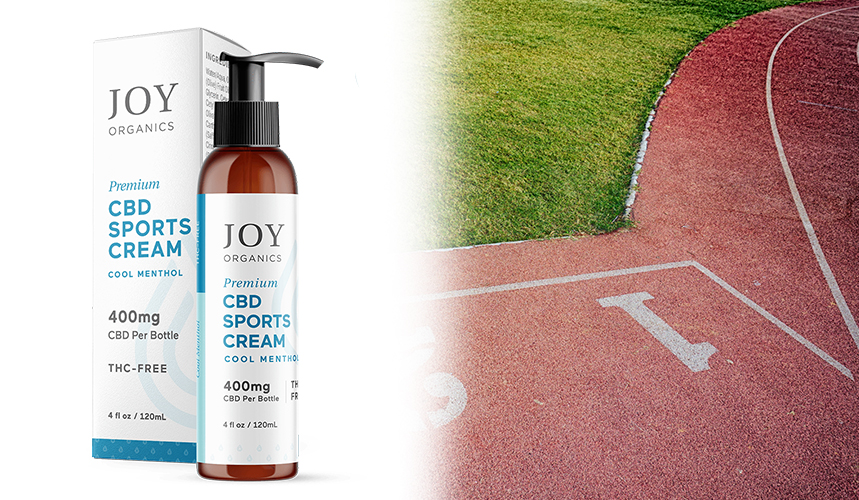
We love this sport cream from Joy Organics to soothe and support healthy muscles. We recommend using the cream at any time- before, during or after your workout. We love this vegan cream that’s packed with 400mg of Premium CBD and enhanced with the benefits of menthol and camphor as topical analgesics to keep you feeling calm and cool when you’re on the move.
Best Full Spectrum Salve: Pure Relief Pain Salve
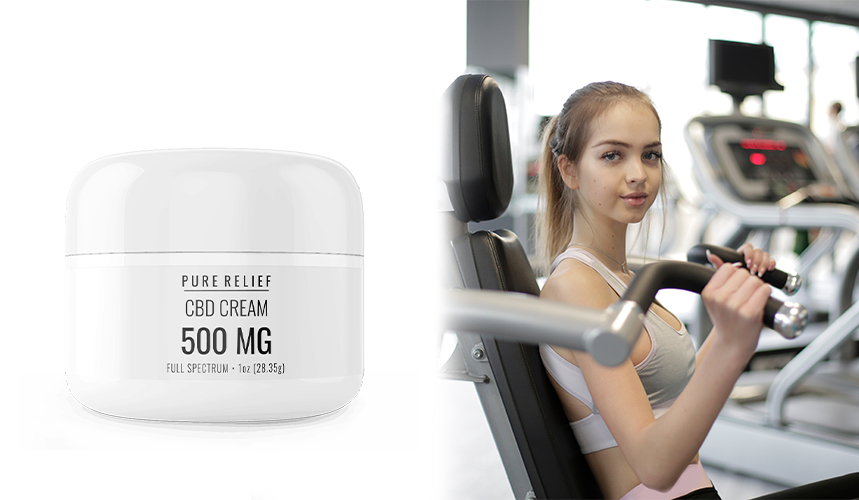
This multi-purpose salve has a high full spectrum CBD content, 500 mg, and deeply penetrating and nourishing essential oils to enhance the relieving effects of this salve. The primary ingredient is cold pressed hemp oil, but other helpful anti-inflammatories and healthy trace minerals like arnica and magnesium assist the pain-relieving effects of CBD. We love the scent, and the powerful relief this salve provides for aching muscles.
Best for Sore Muscles: Aspen Green Cooling Cream
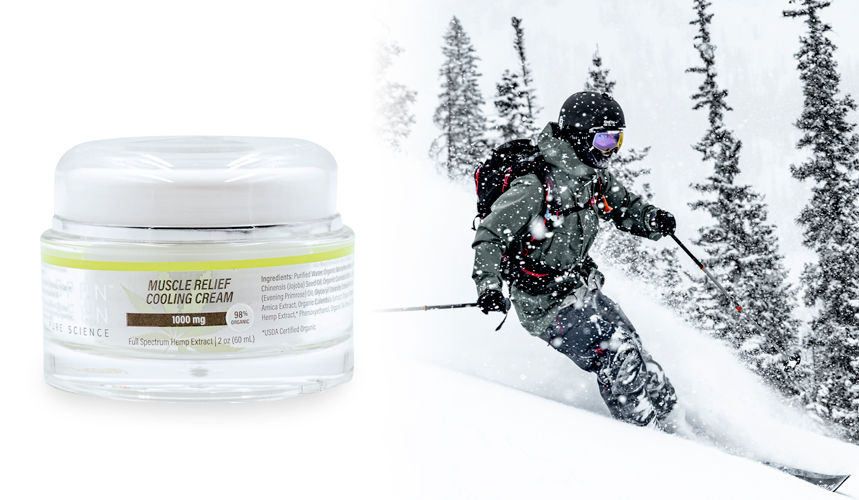
Aspen Green makes an amazing super cooling cream for when you’re feeling burnt out. Their products deliver a full spectrum of phytonutrient-rich whole hemp plant extracts, including pure CBD, without the psychoactive effects of THC. This cream brings in the deeply penetrating and moisturizing oils of Evening Primrose and Jojoba to make a luxuriously calming and gentle massage cream for major tension areas. Because of it’s cooling ingredients like Tea Tree oil and Menthol, be careful to avoid sensitive areas. They also make a pain balm for deeper issues.
Best for Cold Therapy: Populum Cold Therapy Rub
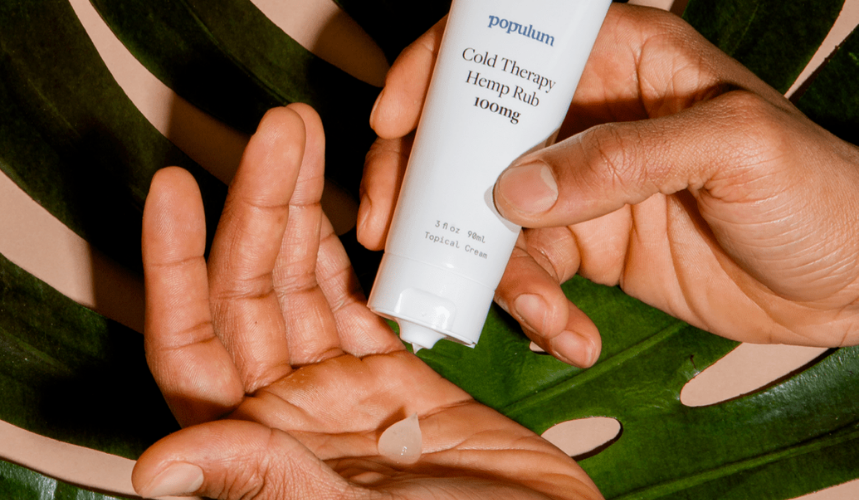
We love Populum for their high quality products and transparent ingredient lists. Their Cold Therapy Hemp Rub is an arctic cold cooling CBD topical cream that helps to soothe and relieve your muscles and joints. This awesome cream is vegan & paraben free, and uses CBD, Arnica, Chamomile, and aloe to offer a quick penetrating chill for your body post workout. But don’t stop there! Populum has an awesome bundle for the full-spectrum athlete available here. Their Advanced Wellness Set includes CBD capsules for on the go, a dropper for more precise dosage, and even includes the Cold Rub mentioned above to soothe your sore muscles and joints.
Best Menthol Infused Topical for Muscle Soreness: mintedLeaf Menthol Cream
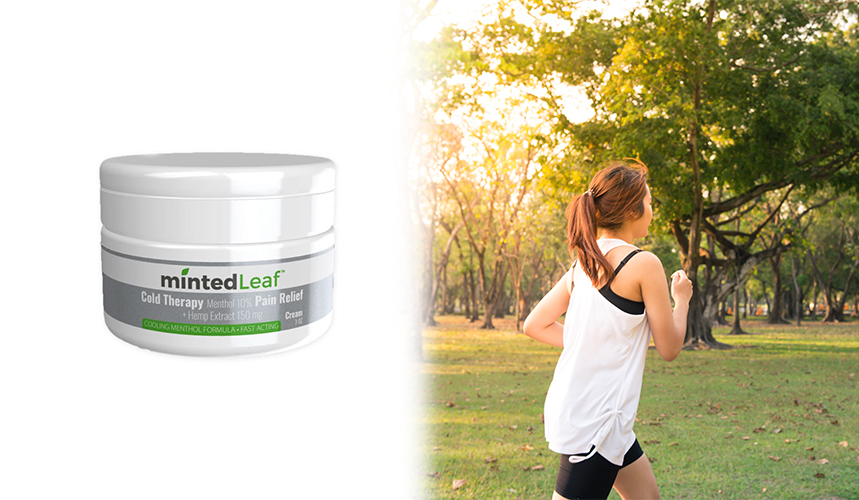
We love this Menthol cream from mintedLeaf for daily pain management. Apply it to temporarily reduce pain associated with sore muscles, sore joints, arthritis, backaches, sprains, strains and bruises. This cream uses the power of 10% menthol for quick relief, as well as 150mg of broad spectrum THC-Free CBD and other moisturizing oils. Keep this menthol cream nearby as a quick fix for pain on the go!
Best Topical for Inflammation: cbdMD Recover Inflammation Cream
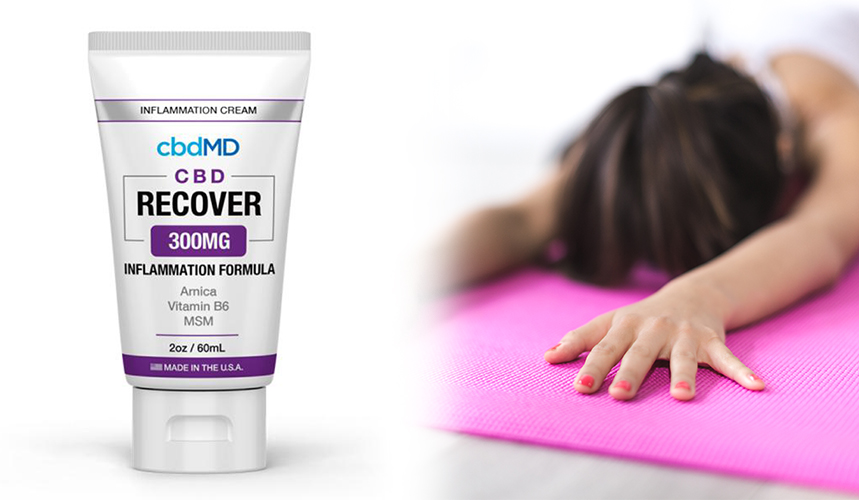
High Quality CBD alone already has great anti-inflammatory effects, but cbdMD goes above and beyond again with their inflammation cream. Designed specifically for recovery it has an incredible 750mg of THC-free organically farmed hemp as well as Arnica, Vitamin B6, and MSM for a full profile anti-inflammatory and muscle support. With this cream, every ingredient has a special purpose: Arnica enhances white-cell stimulation, Vitamin B6 to repair inflammatory and arthritic damage, and MSM for increased flexibility and absorption within cellular walls. We love this cream to be proactive and bounce back quickly to optimal performance in our workouts.
Best Topical with Arnica Support: SERENE CBD Arnica Pain Cream
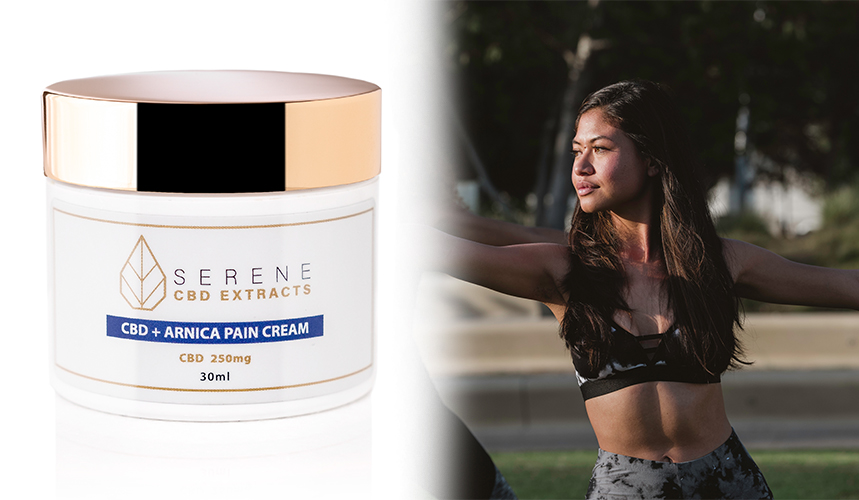
SERENE’s Arnica Pain Cream combines the pain relieving power of CBD with Arnica, MSM and other natural plant derived remedies to quiet the pain signals in your brain, stimulate blood circulation to soothe joint pain and reinvigorate tired and aching muscles. We absolutely love this cream for it’s sweet, minty and slightly piney scent and instantaneous heating sensation on the skin for mild yet fast, effective pain relief. Even better for the neck and shoulders, no greasy residue and a scent that dissipates after application so you can go out confidently without smelling like a ‘pain- relief balm’ We also really appreciate that SERENE leaves out the potentially irritating camphor- so this can be used almost everywhere externally on the body!
Best to Soothe Sore Muscles and Joints: Canna Comforts Pain Cream
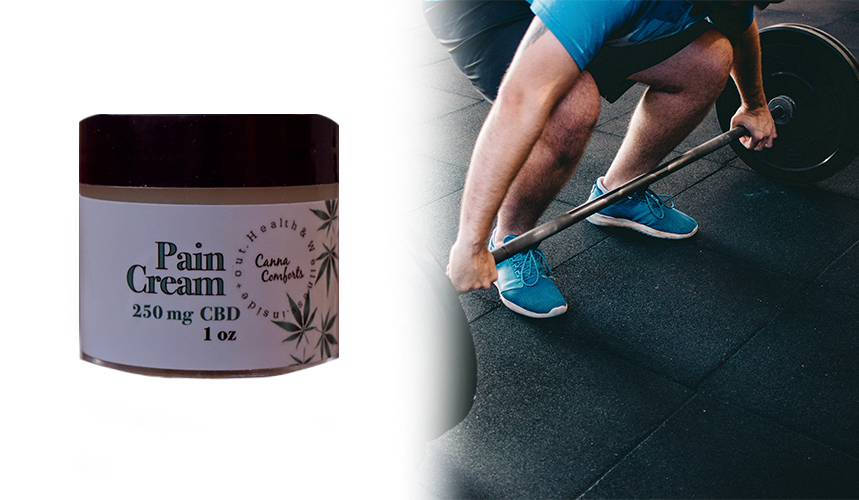
This amazing cream by Canna Comforts is a fast acting cream that comes in 3 scents with different terpene profiles to enhance the entourage effect of the transdermal CBD relief! Only the best CBD pain cream! Infused with Terpenes to give an entourage effect. Choose from 3 scents for your use, Blueberry Yum Yum, Paris OG, and tried and true Menthol. Their proprietary all organic herbal blend is infused with Extra Virgin Olive Oil, Coconut Oil, Shea butter, Beeswax, and 250 mg of Hemp CBD. Soothe sore joints and healing muscles anytime with this unique terpene focused pain cream.
Best Synergistic Bundle for Muscular Discomfort: Specktra Pain Relief Bundle
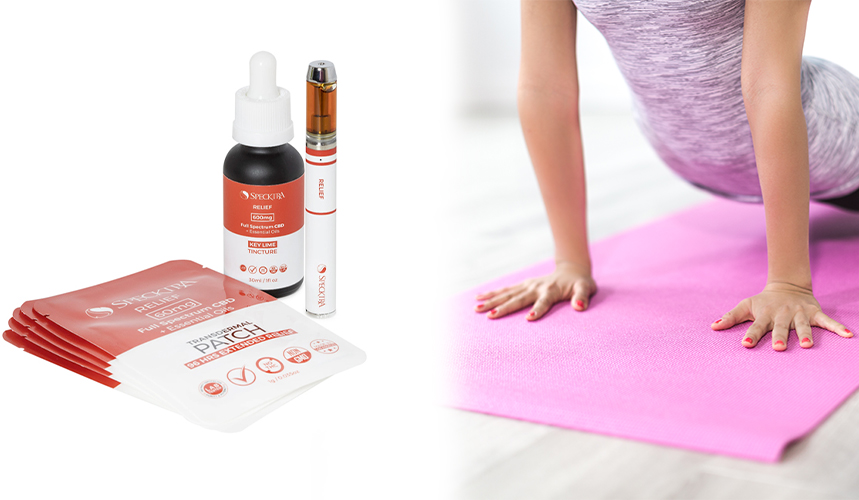
Specktra comes through with tried and true products for CBD consumers providing the best combination to get natural long-lasting relief. The Specktra Pain Relief bundle includes a CBD vape for quick and effective direct effects of CBD, an oral tincture for specific and high dosing if you need, and the amazing transdermal Relief CBD patches that can be worn up to 4 days to provide pain relief. Not only that, but all Specktra products are additive-free, pesticide-free, no harmful fillers, formulated with organic essential oils only, and harness the power of full-spectrum phytocannabinoid rich CBD.










